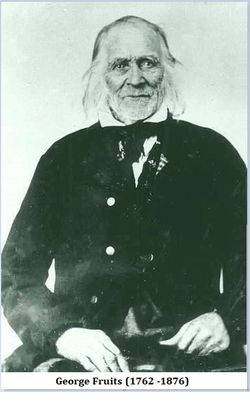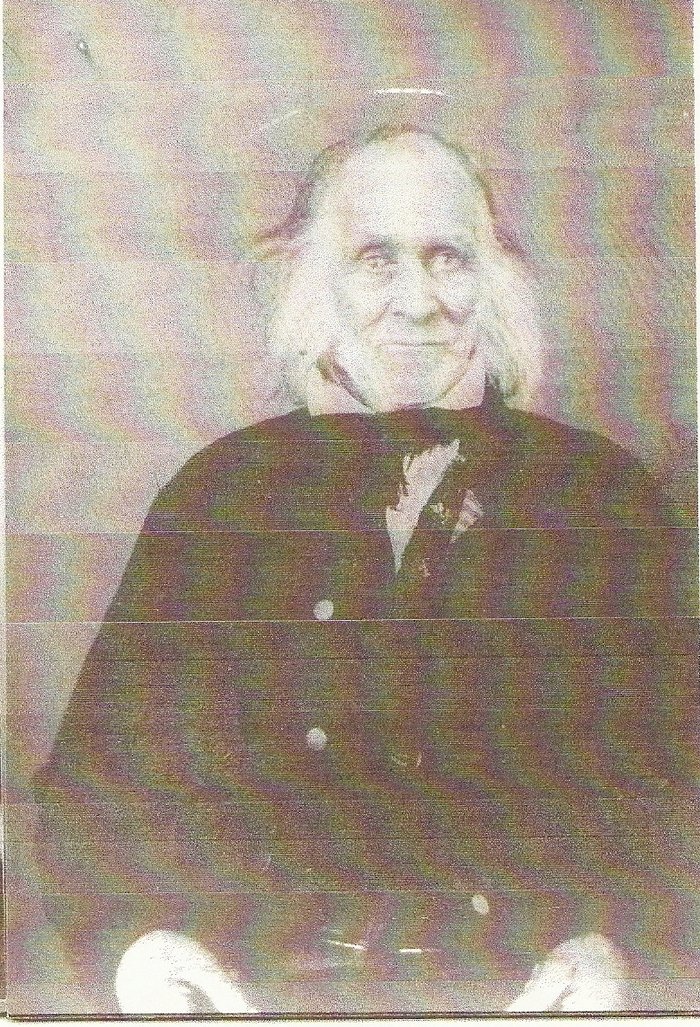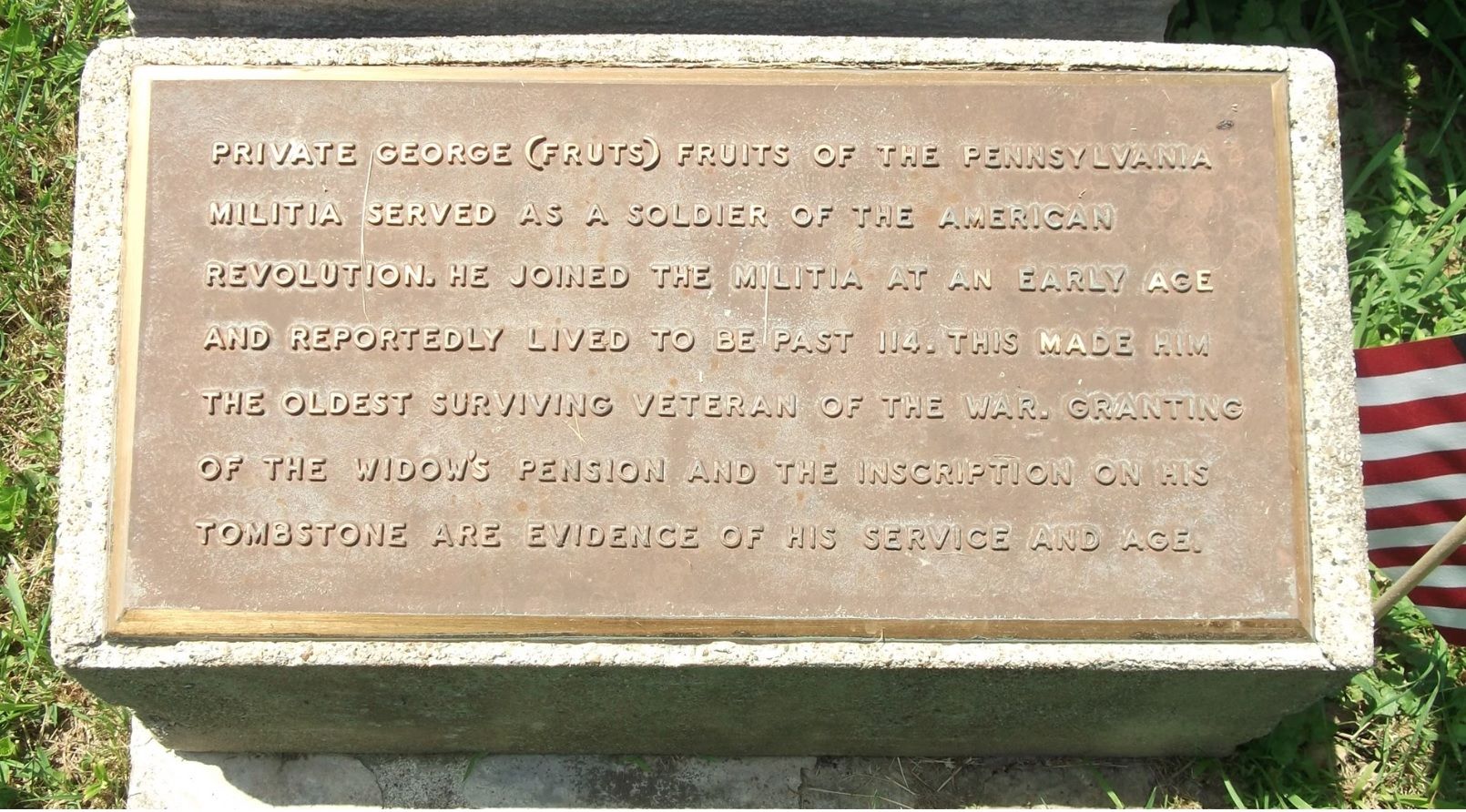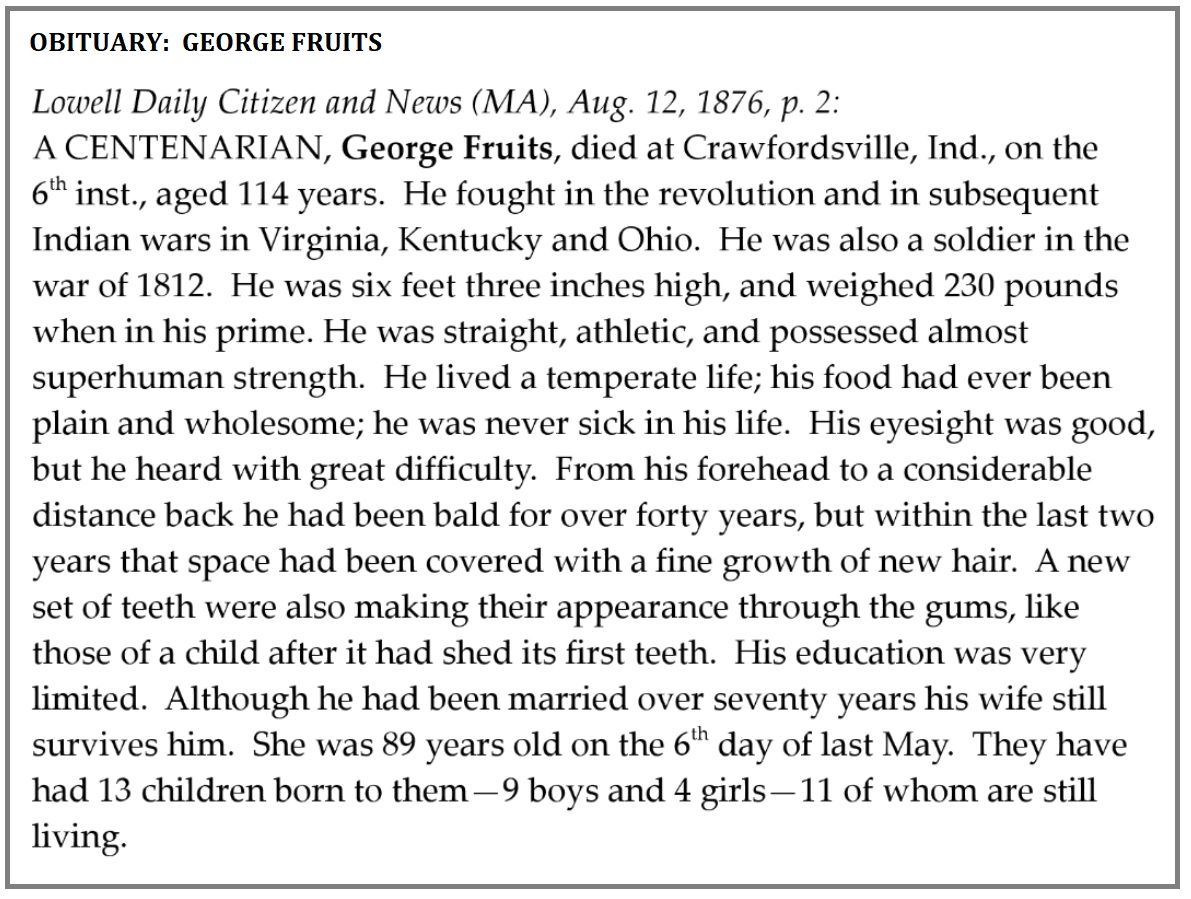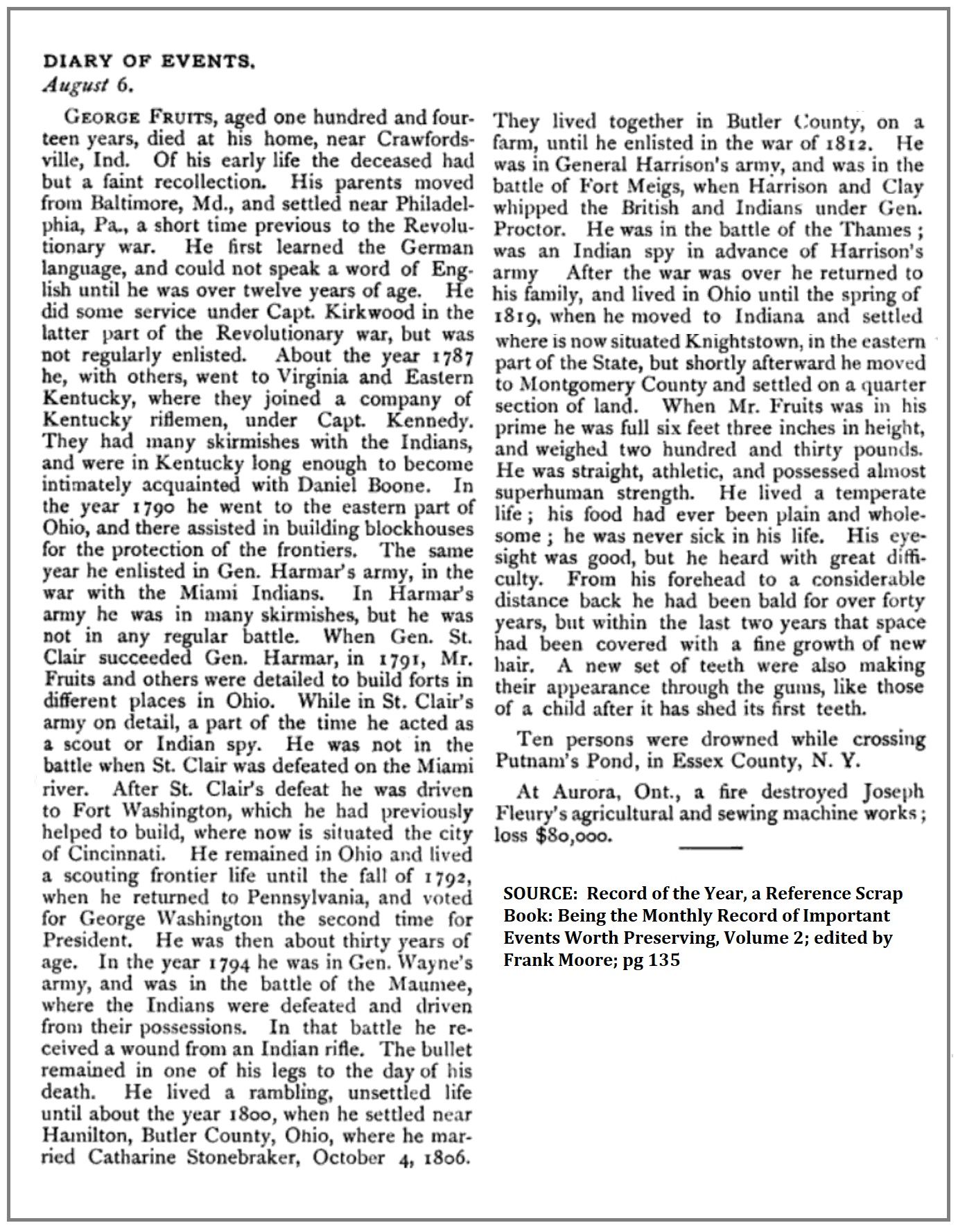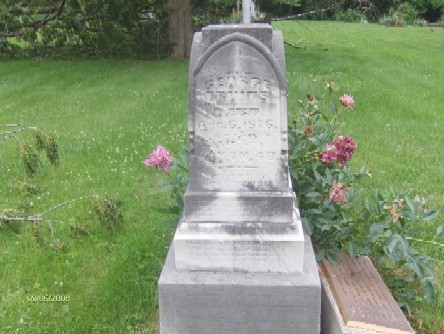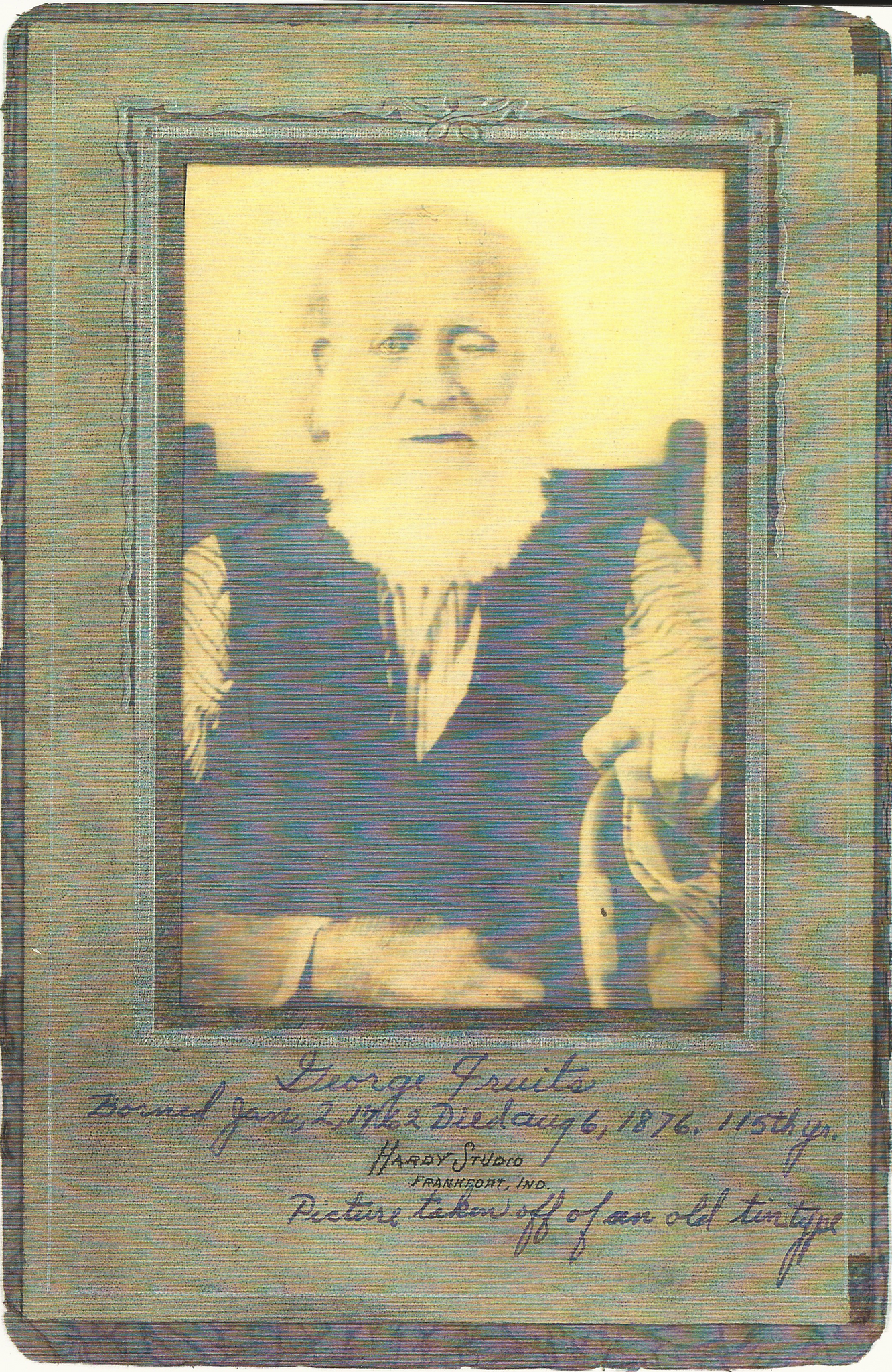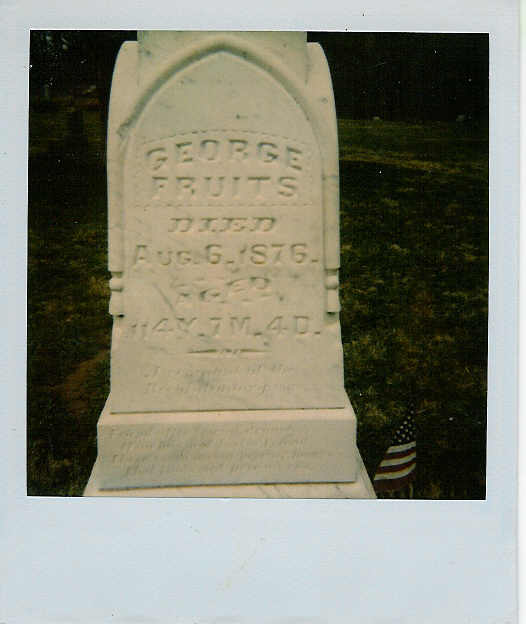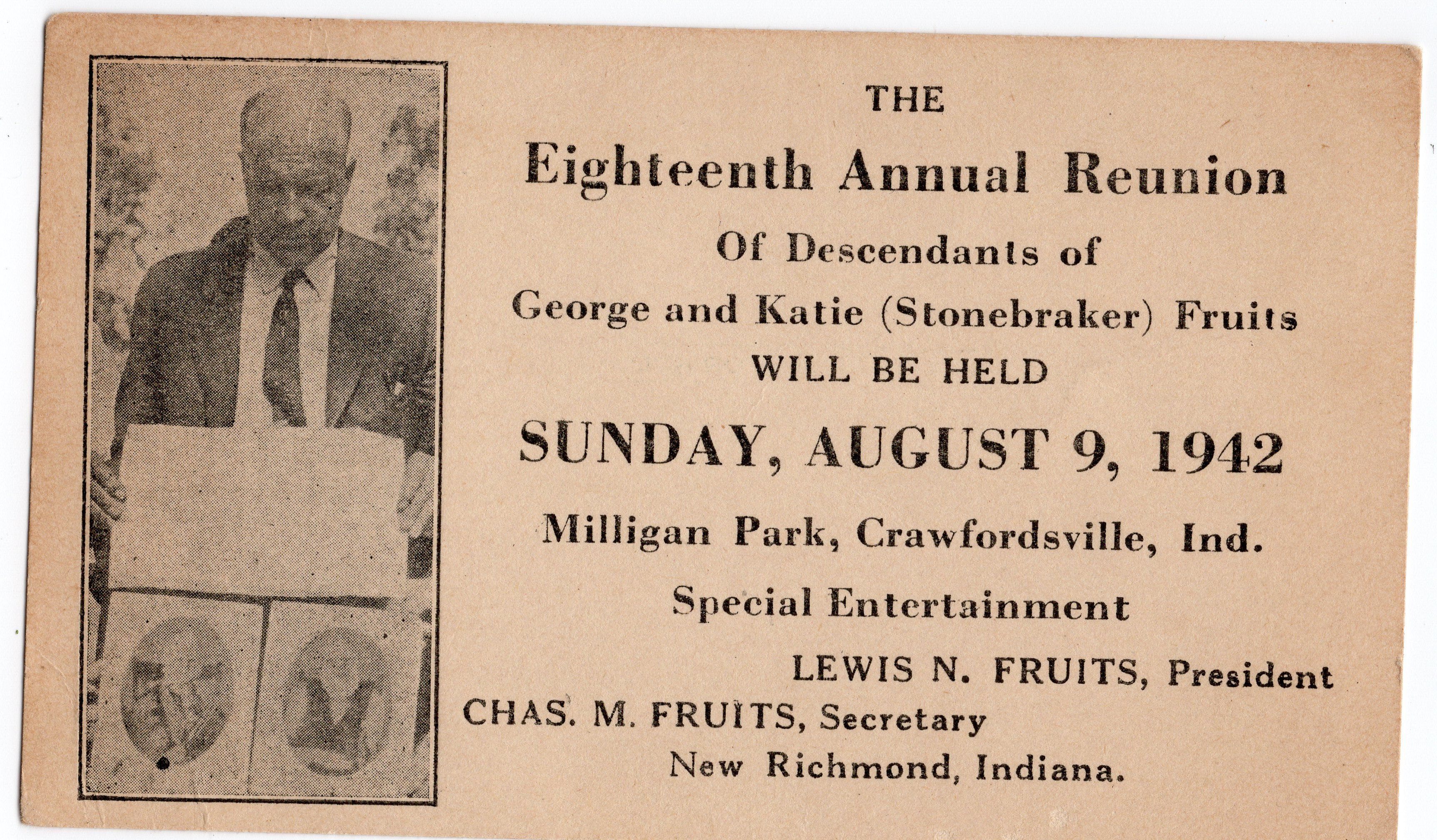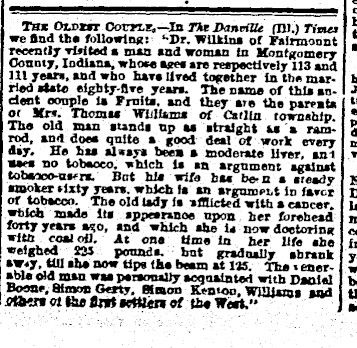GEORGE FRUITS. He was known as the last survivor of the American Revolution and referred to by many as "Alamo George". He was born in 1762 and lived to the ripe age of 114 years, 7 months, and 4 days when he passed away on August 6, 1876. He was listed in the 1977 edition of GUINNESS BOOK OF WORLD RECORDS as one of the longest living human beings on record. But the 1979 edition made a correction as "new research released by A. Ross Eckler in 1978 has shown him to be 17 years younger than the age shown on his gravestone."
There is some controversy over the identity of the last surviving veteran of the Revolutionary War. DAR records indicate that it was probably George's father, George Fruits Sr. who was the Revolutionary War Patriot and not George Jr. Additionally, census records show George Jr. was about 10 years younger in age declarations. This should not discard the fact that he was a HONARABLE PATRIOT of this country and his wife received a Widow's pension for his service in the War of 1812 also known as “Second War of Independence”.
Fruits' military service record showed he received pay in 1781 and 1783 while in the Revolution. He stated he was not involved in any battles because the war was almost over when he joined and that his service involved was "just mopping up operations" in 1781-83. In 1787, George Fruits joined a company under Captain Kennedy to fight the Indians in Kentucky and along the Ohio River. While in Kentucky, he became acquainted with Daniel Boone. During this service, Fruits was cut off from his company. To avoid capture, he "swam across the Ohio River" to the other side with his boots on, not losing his knapsack or rifle. George Fruits enlisted in the War of 1812 and was in the Battle of the Thames where the Indian chief Tecumseh was killed. In this battle, Fruits was wounded by an Indian musket and carried to his grave the one-ounce lead ball lodged in his hip.
George Fruits, Sebastian Stonebraker (father in law), with their wives, are buried in Bunker Hill Cemetery (aka Stonebraker Cemetery) two miles east of Alamo on County Road 400 S. The Revolutionary War patriots' graves are kept decorated by a Flag placed by local organizations. On October 9, 1977 there was a special wreath-laying ceremony at their graves was held by the Susan E. Wallace Society, Children of the American Revolution. On October 14, 1979 the Montgomery County Historical Society held a special dedication ceremony at the grave site of George Fruits honoring him as the nations last survivor of the Revolutionary War. This fact has been authenticated by the Historical Society and has replaced the foundation of the tombstone and installed a bronze commemorative marker in the foundation.
SOURCE: The Journal Review, October 11, 1979, Crawfordsville, Indiana.
------------------------------------------/
Crawfordsville ~ Star, Jan 18, 1876:
"Alamo News" - George Fruits, Sen., better known as "grand-pap" Fruits, has been very ill for some time. Last Wednesday he had his will written by Uncle Santy Gray. He claims to have been 113 years old on the 2d of January, instant, and now thinks his time here on earth is very short. Of him it will ever be said that he has been the poor man's friend all through life
--------------------------------------------------/
"The New York Times Aug 10, 1876 :
GEORGE FRUITS, aged 114 years died at his home, near Crawfordsville, Indiana on the 6th inst. Of his early life, the deceased had but a faint recollection. His parents moved from Baltimore and settled near Philadelphia a short time previous to the Revolutionary War. He first learned the German language and could not speak a word of English until he was over 12 years of age. He did some service under Capt. Kirkwood in the latter part of the Revolutionary War, but was not regularly enlisted. About the year 1787, he, with others, went to the eastern part of Ohio, and there assisted in building block houses for the protection of the frontiers. The same year he enlisted in Gen. Harmar's army in the war with the Miami Indians. In Harmar's army he w as in many skirmishes, but he was not in any regular battle. When Gen St Clair succeeded Gen Harmar in 1791, Mr. Fruits and others were detailed to build forts in different places in Ohio. While in St. Clair's army on detail, a part of the time he acted as a scout or Indian spy. He was not in the battle when St. Clair was defeated on the Miami River. After St. Clair's defeat he was driven to Ft. Washington which he had previously helped build where now is situated the City of Cincinnati. He remained in Ohio and lived a scouting frontier life until the Fall of 1792, when he returned to Pennsylvania and voted for George Washington the second time for President. He was then about 30 years of age. In the year 1794 he was in Gen. Wayne's army and was in the battle of Maumee, where the Indians were defeated and driven from their possessions. In that battle he received a wound from an Indian rifle. The bullet remained in one of his legs to the day of his death. He lived a rambling, unsettled life until about 1800, when he settled near Hamilton, Butler County, Ohio where he married Catharine Stonebraker Oct 4, 1806. They lived together in Butler County on a farm until he enlisted in the war of 1812. He was in Gen. Harrison's army and was in the battle of Fort Meigs, when Harrison and Clay whipped the British and Indians under Gen. Proctor. He was in the battle of the Thames; was an Indian spy in advance of Harrison 's army. After the war was over, he returned to this family and liv ed in Ohio until the Spring of 1819, when he moved to Indiana and settled where is now situated Knightstown in the eastern part of the state but shortly afterward he moved to Montgomery County and settled on a quarter section of land. When Mr. Fruits was in his prime he was tall six feet three inches in height and weighed 230 pounds. He was straight, athletic, and possessed almost superhuman strength. He lived a temperate life; his food had ever been plain and wholesome; he was never sick in his life. His eyesight was good, but he heard with great difficulty. From his forehead to a considerable distance back he had been bald for over 40 years but within the last two years that space had been covered with a fine growth of new hair. A new set of teeth were also making their appearance through the gums like those of a child after its shed its first teeth. His education was very limited. Although he has been married over 70 years, his wife still survives him. She was 89 years old the 6th day of last May. They have had 13 children born to them 9 boys and 4 girls, 11 of whom are still living."
------------------------------------------------------/
GEORGE FRUITS : January 2, 1762 - August 6, 1876 "ALAMO GEORGE" Last of the Original Frontiersmen ----- LAST SURVIVOR OF THE AMERICAN REVOLUTION George Fruits, II had been a loyal democrat since the party was formed and intended to remain so. George was skeptical of religion and said his religion was the "Golden Rule" doing unto others as he would have them to unto him. George was well liked and respected by his neighbors, and had no trouble with any of them. He did not boast of his war record and only discussed his involvement with his family and closest friends. He felt that it was wrong for a man to brag about what he had done for his country. It is reported that George was a humble and highly patriotic man with a love for his country deeply imbedded in his heart. Despite his toughness and courageous nature, George Fruits, II was considered a compassionate man. He and also his father, "Flag Bearer George", expected no more from their country than for them to have the right to make their way in this country with their own hands. They wanted to live among honest people, but first they wanted to be honest themselves.
George Fruits, II or "Alamo George" was born in or near Baltimore, Maryland on January 2, 1762. When he died at the age of 114 years, seven months and four days (inscribed on his original tombstone) on August 6, 1876, his funeral procession, as reported by newspapers, from his home to his burial place in the Bunker Hill-Stonebraker cemetery east of Alamo, Indiana, was over a mile in length. Newspaper articles allege that George was deeply hurt when he was refused enlistment in the CIVIL WAR due to his advanced age - he was age 99 at the time.
"Alamo George's" parents were "Flag Bearer George" and Margaret Fruits, young immigrants from Germany. "Flag Bearer George" died in 1811 and his wife, Margaret, in 1826. Both are buried near Brookville, Franklin County, Indiana, where the elder George's will was the first to be probated in that county (1804). This immigrant couple was married near Baltimore, Maryland, but moved to Washington County, Pennsylvania prior to the American Revolution. The exact date of this move is unknown, unfortunately, so the birth places of their five sons and four daughters cannot be verified. It is believed, however, that the elder George, in 1793, loaded up his family and belongings in a flat boat and went down the Ohio River to settle for a few years in Fleming County, Kentucky. In 1802, the family moved to what is now Franklin County, Indiana. According to an old Franklin County atlas, the Fruits family was among the very first to settle in the state of Indiana. "Alamo George", the second of "Flag Bearer George's" nine children, stated that he was born in Maryland. There is some evidence that "Flag Bearer George" also fought in many important American Revolutionary battles (sometimes along side of his son), and many times carrying only the stub of the flag staff ... the rest shot away. Although reportedly never wounded while carrying out his assignment as flag bearer, he once had the heel of his boot shot off, according to family legend.
"Alamo George" married CATHERINE STONEBRAKER on October 29, 1808, near the town of Hamilton, Butler County, Ohio. The marriage was performed by one William Smith, Justice of the Peace. Her father, Sebastian Stonebraker (married to Susannah Yeakle), signed the marriage bond. Catherine was born on May 6, 1790, and died August 17, 1880 (age 90). It is interesting to note that this was the first marriage of both George and Catherine thereto, and that "Alamo George" was forty-six years of age and Catherine was only eighteen years of age at the time of this marriage. Sebastian Stonebraker moved his wife and family from Ohio to Alamo, Ripley Township, Montgomery County, Indiana after "Alamo George" and Catherine were married, and he and his wife were both buried in Bunker Hill-Stonebraker cemetery, which is just a few feet east of the graves of "Alamo George" and Catherine Stonebraker-Fruits.
"ALAMO GEORGE" FRUITS, HIS FATHER "FLAG BEARER GEORGE" FRUITS, SEBASTIAN STONEBRAKER (Catherine's father), and GEORGE YEAKLEY (Catherine's grandfather) proudly served in the Revolutionary War. Catherine's Widow's Claim for Pension executed under oath on December 23, 1878, two years after George's death and supported by affidavits of William McMaker and Joseph Sweringen on the same date. The Widow claim was allowed based on George's service in the WAR OF 1812. EXCERPTS from the above Widow's Claim :
"George Fruits served in Captain Kirkwood's Company of Pennsylvania Militia in the Revolutionary War. He was also in the militia under Captain George Miars, joining on November 2, 1781, Washington County, Pa, as a private, making him close to a 20 year old at that time." (Vol. 2, pages 168-246, Pa. Archives, 6th series.)
Note: According to an article published in the Vinton-Iowa-Eagle newspaper, dated June 21, 1876, entitled, "A Centennial Couple", the author states: "when but a boy he served in the Continental Army under Washington", and George's lengthy obituary entitled, "Pioneer Sketch of the Life of a Centenarian", Crawfordsville (Indiana) Journal, August 7, 1876 ... "he entered the Washington County Militia, June 20, 1777", making George a boy of 15 at his original entry as a volunteer into the American Revolution.
Catherine continues: "In 1787, he moved from Pennsylvania to eastern Kentucky where he joined a company of Kentucky Riflemen under Captain Kennedy during which service he participated in many skirmishes with the Indians. In 1790, he enlisted in General Harmar's Army in the war with the Miami Indians, and was in many skirmishes but no big battles. When General Harmar was succeeded by General St. Clair, George was detailed to build certain forts in Ohio, namely Ft. Jefferson, now Eaton, Ohio; Ft. Drake, now Greenville, Ohio; and Ft. Washington, now Cincinnati, Ohio. In 1792, he returned to Pennsylvania and voted for GEORGE WASHINGTON the second time for President." The Crawfordsville, Indiana Chapter of the D.A.R. discovered several years ago war records showing that "Alamo George" received pay in 1781 and again in 1783 while serving in the revolution. The reason that George almost was lost to history was that George had NEVER made an application for pension, feeling that his war service was owing to his country. In 1794, "Alamo George" enlisted in General Wayne's army and was in the BATTLE OF THE MAUMEE, in which battle he received a wound in his right thigh. He carried the musket ball causing the wound to his grave several decades later. A courageous scout on the frontier for over 40 years at the time of his death, "Alamo George" enlisted after the revolution in General Harrison's Army in the War of 1812 in Butler County, Ohio, and served under Captail Leas and Captain Carsady while they were quartered near the Rapids of the Maumee. He was in the BATTLE OF FORT MEIGS where the British General Proctor was defeated. He was also in the BATTLE OF THE THAMES and served as a scout in advance of General Harrison's Army. " Simon Kenton, the great
frontiersman and personal friend to "Alamo George", was called upon to identify the body of
TECUMSEH, having also been a friend of TECUMSEH's at one time. Kenton, therefore, knowing full well what would happen if he positively identified the body as that of TECUMSEH, deliberately identified Chief ROUNDHEAD as TECUMSEH, whereupon the soldiers laid claim to various ornaments and proceeded to cut strips of hide off the dead chief for souvenirs. It is interesting to note that one William Bratton was also in the above battle and brought back a bullet pouch which he purchased for one dollar, which was "supposed" to have been TECUMSEH's, but was actually Chief Roundhead's. This same William Bratton was a member of the Lewis and Clark expedition to the Rocky Mountains. He is buried in the Pioneer Cemetery at the east edge of Waynetown, Indiana. ( -- Source re Tecumseh, "The Frontiersman" - Eckert.)
Wife Catherine Fruits' statements contained in her Widow's Pension Claim:
"At the time of his enlistment in the War of 1812, he was six feet three inches in height, dark grey eyes, black hair, fair complexion, and a farmer by occupation. Following have been places of residence since the date of his discharge from service in the WAR OF 1812 in Butler County, Ohio, till in the year of 1819, when we came to eastern Indiana (Knightstown area) where we remained until in the year 1827 when we came to Montgomery County, Indiana, and settled on a quarter section of land to which George had received a deed from the United States dated May 24, 1826."
Note: Catherine's statement that the family remained in the Knightstown until 1827 conflicts with George's statement in which he stated they lived in Alamo for five years before the deed was signed by President J. Q. Adams in 1826. George probably laid claim to the land in 1820 and the family remained in Knightstown until 1827 as it probably five years to clear the wilderness land and build the house. where they remained in until his death in 1876.
At the time of "Alamo George's" death in 1876, six of his sons were at his bedside, all residing in the Alamo, Indiana area. It must be assumed that the whole family joined in the preparation of this claim. Also, Catherine was known to have a very keen mind and an excellent command of the English language even though she only spoke German until she was fifteen years of age. Although Catherine had no education and was illiterate, she still had total recall as to names and dates.) * An article published in the Vinton (Iowa) Eagle (June 21, 1876) emerged as a reprint of an earlier article printed in The Indianapolis Journal entitled, "A Centennial Couple". It was a write-up of a personal visit and interview with George and Catherine Fruits in their home near Alamo, Indiana.
The below are not verbatim excerpts from the above articles, but make up a summary of same: The interviewer was shown the ORIGINAL DEED to their farm, located about halfway between Alamo and Yountsville, signed by PRESIDENT JOHN QUINCY ADAMS and dated 1826. George had received this land as a part of his war service pay, on which he built a log house which was considered a mansion in its day. He had learned his master craftsmanship while detailed in the service to help build forts and block houses on the frontier. Footnote: In 1828, the election in Ripley Township was held in George Fruits' log house. Matt Elmore gave this account of that election:
“The ballots were written out by Jim Gilkey with a goose quill pen and polk-berry ink and there were several Revolutionary soldiers there - Fruits, Warren Miller, and Weir. Old man Fruits lived to be well over 100 years and was a powerful good man. All the old soldiers voted for General Jackson."
George said they had lived on their farm for five years before they received their land deed signed by the President (see clarification on discrepancy). The interviewer was also invited to feel George's third set of teeth, which were truly emerging. More power to George; he bit down on the doubting interviewer's fingers, which were feeling the mostly emerged teeth. At this time, George was also growing a fine growth of new white hair over his previously bald spot. The writer also described George as being a powerful figure of a man with long arms and a lean muscular figure. His eyes had faded to a light blue and the left eyelid had completely dropped to cover his left eye due to weakening of the muscles in the eyelid.
Photos of George show a weakened right eyelid. Family descendants claim he was an early riser with regular eating habits. He used tobacco and whiskey many years ago but never to excess. With the exception of the time he was a soldier, and four years as a tanner, and six years as a distiller, he had been a farmer and scout. After moving to the Alamo, George gave up entirely alcohol and tobacco and refused drink coffee or tea or use stimulants of any kind. The writer also brings up a discrepancy between his interview and Catherine Stonebraker Fruits' application for Widow's Pension. The writer states that George now carried a one-ounce lead ball in one of his legs - shot there by an Indian musket at the BATTLE OF BLUE LICKS, Licking Creek, Kentucky - November, 1782...where one of Daniel Boone's sons was killed and where Daniel was also engaged in battle... instead of at THE BATTLE OF THE MAUMEE , as earlier noted.) The interviewer also states, when Kentucky was opened to settlers, George went there where he took an active part in the Indian Wars. His comrades included DANIEL BOONE (and family), SIMON KENTON, and other well known characters in the colonial history of Kentucky. He spent much of his time in the erection of block houses and other means of defense for the settlers, and was well known as a daring scout. He missed the BATTLE OF NEW ORLEANS as he was left behind to guard Ft. Washington (now Cincinnati, Ohio).
This concludes the summary of the Indianapolis Journal article as copied by the Vinton, Iowa, Eagle, which also stated that George and Catherine had been invited to attend the Centennial Celebration, but their ages (114 and 88 respectively) and feebleness made that impossible. Catherine's Claim for Widow's Pension, along with the above article summary, standing alone give about as accurate of a history of "Alamo George" and his wife, Catherine, as one could desire, although a chronological TIME LINE comparison of other occurring events George was effected by and/or was indirectly or indirectly involved in will help those interested in more detail to bring things into more understandable perspective, and can be viewed on this site by clicking on the TIME
George and Catherine Fruits' farm ("The Homeplace") was located at the intersection of Montgomery County Roads numbered 200 South and 700 West. The northwest corner of the farm was this intersection. The legal description is as follows: "The Northwest Quarter of Section 18, Township 18 North, Range 5 West in Montgomery County, Indiana, being 159.6 acres. (Ripley Township).
George's obituary (see attached) indicated six of his sons were present at his death bed. It also says that he was only bedfast for six days prior to his death and refused opiates of any kind for pain.
The Will of George Fruits, dated January 5, 1876, named his sons John and George as executors; his daughter, Susanah died on January 14, 1861, and that her share of his estate should go to her children. George and Catherine had thirteen children (one died in infancy). The last child Michael Yeakel Fruits was born May 13, 1836, when George was 74 and Catherine was 46.
GEORGE FRUITS. He was known as the last survivor of the American Revolution and referred to by many as "Alamo George". He was born in 1762 and lived to the ripe age of 114 years, 7 months, and 4 days when he passed away on August 6, 1876. He was listed in the 1977 edition of GUINNESS BOOK OF WORLD RECORDS as one of the longest living human beings on record. But the 1979 edition made a correction as "new research released by A. Ross Eckler in 1978 has shown him to be 17 years younger than the age shown on his gravestone."
There is some controversy over the identity of the last surviving veteran of the Revolutionary War. DAR records indicate that it was probably George's father, George Fruits Sr. who was the Revolutionary War Patriot and not George Jr. Additionally, census records show George Jr. was about 10 years younger in age declarations. This should not discard the fact that he was a HONARABLE PATRIOT of this country and his wife received a Widow's pension for his service in the War of 1812 also known as “Second War of Independence”.
Fruits' military service record showed he received pay in 1781 and 1783 while in the Revolution. He stated he was not involved in any battles because the war was almost over when he joined and that his service involved was "just mopping up operations" in 1781-83. In 1787, George Fruits joined a company under Captain Kennedy to fight the Indians in Kentucky and along the Ohio River. While in Kentucky, he became acquainted with Daniel Boone. During this service, Fruits was cut off from his company. To avoid capture, he "swam across the Ohio River" to the other side with his boots on, not losing his knapsack or rifle. George Fruits enlisted in the War of 1812 and was in the Battle of the Thames where the Indian chief Tecumseh was killed. In this battle, Fruits was wounded by an Indian musket and carried to his grave the one-ounce lead ball lodged in his hip.
George Fruits, Sebastian Stonebraker (father in law), with their wives, are buried in Bunker Hill Cemetery (aka Stonebraker Cemetery) two miles east of Alamo on County Road 400 S. The Revolutionary War patriots' graves are kept decorated by a Flag placed by local organizations. On October 9, 1977 there was a special wreath-laying ceremony at their graves was held by the Susan E. Wallace Society, Children of the American Revolution. On October 14, 1979 the Montgomery County Historical Society held a special dedication ceremony at the grave site of George Fruits honoring him as the nations last survivor of the Revolutionary War. This fact has been authenticated by the Historical Society and has replaced the foundation of the tombstone and installed a bronze commemorative marker in the foundation.
SOURCE: The Journal Review, October 11, 1979, Crawfordsville, Indiana.
------------------------------------------/
Crawfordsville ~ Star, Jan 18, 1876:
"Alamo News" - George Fruits, Sen., better known as "grand-pap" Fruits, has been very ill for some time. Last Wednesday he had his will written by Uncle Santy Gray. He claims to have been 113 years old on the 2d of January, instant, and now thinks his time here on earth is very short. Of him it will ever be said that he has been the poor man's friend all through life
--------------------------------------------------/
"The New York Times Aug 10, 1876 :
GEORGE FRUITS, aged 114 years died at his home, near Crawfordsville, Indiana on the 6th inst. Of his early life, the deceased had but a faint recollection. His parents moved from Baltimore and settled near Philadelphia a short time previous to the Revolutionary War. He first learned the German language and could not speak a word of English until he was over 12 years of age. He did some service under Capt. Kirkwood in the latter part of the Revolutionary War, but was not regularly enlisted. About the year 1787, he, with others, went to the eastern part of Ohio, and there assisted in building block houses for the protection of the frontiers. The same year he enlisted in Gen. Harmar's army in the war with the Miami Indians. In Harmar's army he w as in many skirmishes, but he was not in any regular battle. When Gen St Clair succeeded Gen Harmar in 1791, Mr. Fruits and others were detailed to build forts in different places in Ohio. While in St. Clair's army on detail, a part of the time he acted as a scout or Indian spy. He was not in the battle when St. Clair was defeated on the Miami River. After St. Clair's defeat he was driven to Ft. Washington which he had previously helped build where now is situated the City of Cincinnati. He remained in Ohio and lived a scouting frontier life until the Fall of 1792, when he returned to Pennsylvania and voted for George Washington the second time for President. He was then about 30 years of age. In the year 1794 he was in Gen. Wayne's army and was in the battle of Maumee, where the Indians were defeated and driven from their possessions. In that battle he received a wound from an Indian rifle. The bullet remained in one of his legs to the day of his death. He lived a rambling, unsettled life until about 1800, when he settled near Hamilton, Butler County, Ohio where he married Catharine Stonebraker Oct 4, 1806. They lived together in Butler County on a farm until he enlisted in the war of 1812. He was in Gen. Harrison's army and was in the battle of Fort Meigs, when Harrison and Clay whipped the British and Indians under Gen. Proctor. He was in the battle of the Thames; was an Indian spy in advance of Harrison 's army. After the war was over, he returned to this family and liv ed in Ohio until the Spring of 1819, when he moved to Indiana and settled where is now situated Knightstown in the eastern part of the state but shortly afterward he moved to Montgomery County and settled on a quarter section of land. When Mr. Fruits was in his prime he was tall six feet three inches in height and weighed 230 pounds. He was straight, athletic, and possessed almost superhuman strength. He lived a temperate life; his food had ever been plain and wholesome; he was never sick in his life. His eyesight was good, but he heard with great difficulty. From his forehead to a considerable distance back he had been bald for over 40 years but within the last two years that space had been covered with a fine growth of new hair. A new set of teeth were also making their appearance through the gums like those of a child after its shed its first teeth. His education was very limited. Although he has been married over 70 years, his wife still survives him. She was 89 years old the 6th day of last May. They have had 13 children born to them 9 boys and 4 girls, 11 of whom are still living."
------------------------------------------------------/
GEORGE FRUITS : January 2, 1762 - August 6, 1876 "ALAMO GEORGE" Last of the Original Frontiersmen ----- LAST SURVIVOR OF THE AMERICAN REVOLUTION George Fruits, II had been a loyal democrat since the party was formed and intended to remain so. George was skeptical of religion and said his religion was the "Golden Rule" doing unto others as he would have them to unto him. George was well liked and respected by his neighbors, and had no trouble with any of them. He did not boast of his war record and only discussed his involvement with his family and closest friends. He felt that it was wrong for a man to brag about what he had done for his country. It is reported that George was a humble and highly patriotic man with a love for his country deeply imbedded in his heart. Despite his toughness and courageous nature, George Fruits, II was considered a compassionate man. He and also his father, "Flag Bearer George", expected no more from their country than for them to have the right to make their way in this country with their own hands. They wanted to live among honest people, but first they wanted to be honest themselves.
George Fruits, II or "Alamo George" was born in or near Baltimore, Maryland on January 2, 1762. When he died at the age of 114 years, seven months and four days (inscribed on his original tombstone) on August 6, 1876, his funeral procession, as reported by newspapers, from his home to his burial place in the Bunker Hill-Stonebraker cemetery east of Alamo, Indiana, was over a mile in length. Newspaper articles allege that George was deeply hurt when he was refused enlistment in the CIVIL WAR due to his advanced age - he was age 99 at the time.
"Alamo George's" parents were "Flag Bearer George" and Margaret Fruits, young immigrants from Germany. "Flag Bearer George" died in 1811 and his wife, Margaret, in 1826. Both are buried near Brookville, Franklin County, Indiana, where the elder George's will was the first to be probated in that county (1804). This immigrant couple was married near Baltimore, Maryland, but moved to Washington County, Pennsylvania prior to the American Revolution. The exact date of this move is unknown, unfortunately, so the birth places of their five sons and four daughters cannot be verified. It is believed, however, that the elder George, in 1793, loaded up his family and belongings in a flat boat and went down the Ohio River to settle for a few years in Fleming County, Kentucky. In 1802, the family moved to what is now Franklin County, Indiana. According to an old Franklin County atlas, the Fruits family was among the very first to settle in the state of Indiana. "Alamo George", the second of "Flag Bearer George's" nine children, stated that he was born in Maryland. There is some evidence that "Flag Bearer George" also fought in many important American Revolutionary battles (sometimes along side of his son), and many times carrying only the stub of the flag staff ... the rest shot away. Although reportedly never wounded while carrying out his assignment as flag bearer, he once had the heel of his boot shot off, according to family legend.
"Alamo George" married CATHERINE STONEBRAKER on October 29, 1808, near the town of Hamilton, Butler County, Ohio. The marriage was performed by one William Smith, Justice of the Peace. Her father, Sebastian Stonebraker (married to Susannah Yeakle), signed the marriage bond. Catherine was born on May 6, 1790, and died August 17, 1880 (age 90). It is interesting to note that this was the first marriage of both George and Catherine thereto, and that "Alamo George" was forty-six years of age and Catherine was only eighteen years of age at the time of this marriage. Sebastian Stonebraker moved his wife and family from Ohio to Alamo, Ripley Township, Montgomery County, Indiana after "Alamo George" and Catherine were married, and he and his wife were both buried in Bunker Hill-Stonebraker cemetery, which is just a few feet east of the graves of "Alamo George" and Catherine Stonebraker-Fruits.
"ALAMO GEORGE" FRUITS, HIS FATHER "FLAG BEARER GEORGE" FRUITS, SEBASTIAN STONEBRAKER (Catherine's father), and GEORGE YEAKLEY (Catherine's grandfather) proudly served in the Revolutionary War. Catherine's Widow's Claim for Pension executed under oath on December 23, 1878, two years after George's death and supported by affidavits of William McMaker and Joseph Sweringen on the same date. The Widow claim was allowed based on George's service in the WAR OF 1812. EXCERPTS from the above Widow's Claim :
"George Fruits served in Captain Kirkwood's Company of Pennsylvania Militia in the Revolutionary War. He was also in the militia under Captain George Miars, joining on November 2, 1781, Washington County, Pa, as a private, making him close to a 20 year old at that time." (Vol. 2, pages 168-246, Pa. Archives, 6th series.)
Note: According to an article published in the Vinton-Iowa-Eagle newspaper, dated June 21, 1876, entitled, "A Centennial Couple", the author states: "when but a boy he served in the Continental Army under Washington", and George's lengthy obituary entitled, "Pioneer Sketch of the Life of a Centenarian", Crawfordsville (Indiana) Journal, August 7, 1876 ... "he entered the Washington County Militia, June 20, 1777", making George a boy of 15 at his original entry as a volunteer into the American Revolution.
Catherine continues: "In 1787, he moved from Pennsylvania to eastern Kentucky where he joined a company of Kentucky Riflemen under Captain Kennedy during which service he participated in many skirmishes with the Indians. In 1790, he enlisted in General Harmar's Army in the war with the Miami Indians, and was in many skirmishes but no big battles. When General Harmar was succeeded by General St. Clair, George was detailed to build certain forts in Ohio, namely Ft. Jefferson, now Eaton, Ohio; Ft. Drake, now Greenville, Ohio; and Ft. Washington, now Cincinnati, Ohio. In 1792, he returned to Pennsylvania and voted for GEORGE WASHINGTON the second time for President." The Crawfordsville, Indiana Chapter of the D.A.R. discovered several years ago war records showing that "Alamo George" received pay in 1781 and again in 1783 while serving in the revolution. The reason that George almost was lost to history was that George had NEVER made an application for pension, feeling that his war service was owing to his country. In 1794, "Alamo George" enlisted in General Wayne's army and was in the BATTLE OF THE MAUMEE, in which battle he received a wound in his right thigh. He carried the musket ball causing the wound to his grave several decades later. A courageous scout on the frontier for over 40 years at the time of his death, "Alamo George" enlisted after the revolution in General Harrison's Army in the War of 1812 in Butler County, Ohio, and served under Captail Leas and Captain Carsady while they were quartered near the Rapids of the Maumee. He was in the BATTLE OF FORT MEIGS where the British General Proctor was defeated. He was also in the BATTLE OF THE THAMES and served as a scout in advance of General Harrison's Army. " Simon Kenton, the great
frontiersman and personal friend to "Alamo George", was called upon to identify the body of
TECUMSEH, having also been a friend of TECUMSEH's at one time. Kenton, therefore, knowing full well what would happen if he positively identified the body as that of TECUMSEH, deliberately identified Chief ROUNDHEAD as TECUMSEH, whereupon the soldiers laid claim to various ornaments and proceeded to cut strips of hide off the dead chief for souvenirs. It is interesting to note that one William Bratton was also in the above battle and brought back a bullet pouch which he purchased for one dollar, which was "supposed" to have been TECUMSEH's, but was actually Chief Roundhead's. This same William Bratton was a member of the Lewis and Clark expedition to the Rocky Mountains. He is buried in the Pioneer Cemetery at the east edge of Waynetown, Indiana. ( -- Source re Tecumseh, "The Frontiersman" - Eckert.)
Wife Catherine Fruits' statements contained in her Widow's Pension Claim:
"At the time of his enlistment in the War of 1812, he was six feet three inches in height, dark grey eyes, black hair, fair complexion, and a farmer by occupation. Following have been places of residence since the date of his discharge from service in the WAR OF 1812 in Butler County, Ohio, till in the year of 1819, when we came to eastern Indiana (Knightstown area) where we remained until in the year 1827 when we came to Montgomery County, Indiana, and settled on a quarter section of land to which George had received a deed from the United States dated May 24, 1826."
Note: Catherine's statement that the family remained in the Knightstown until 1827 conflicts with George's statement in which he stated they lived in Alamo for five years before the deed was signed by President J. Q. Adams in 1826. George probably laid claim to the land in 1820 and the family remained in Knightstown until 1827 as it probably five years to clear the wilderness land and build the house. where they remained in until his death in 1876.
At the time of "Alamo George's" death in 1876, six of his sons were at his bedside, all residing in the Alamo, Indiana area. It must be assumed that the whole family joined in the preparation of this claim. Also, Catherine was known to have a very keen mind and an excellent command of the English language even though she only spoke German until she was fifteen years of age. Although Catherine had no education and was illiterate, she still had total recall as to names and dates.) * An article published in the Vinton (Iowa) Eagle (June 21, 1876) emerged as a reprint of an earlier article printed in The Indianapolis Journal entitled, "A Centennial Couple". It was a write-up of a personal visit and interview with George and Catherine Fruits in their home near Alamo, Indiana.
The below are not verbatim excerpts from the above articles, but make up a summary of same: The interviewer was shown the ORIGINAL DEED to their farm, located about halfway between Alamo and Yountsville, signed by PRESIDENT JOHN QUINCY ADAMS and dated 1826. George had received this land as a part of his war service pay, on which he built a log house which was considered a mansion in its day. He had learned his master craftsmanship while detailed in the service to help build forts and block houses on the frontier. Footnote: In 1828, the election in Ripley Township was held in George Fruits' log house. Matt Elmore gave this account of that election:
“The ballots were written out by Jim Gilkey with a goose quill pen and polk-berry ink and there were several Revolutionary soldiers there - Fruits, Warren Miller, and Weir. Old man Fruits lived to be well over 100 years and was a powerful good man. All the old soldiers voted for General Jackson."
George said they had lived on their farm for five years before they received their land deed signed by the President (see clarification on discrepancy). The interviewer was also invited to feel George's third set of teeth, which were truly emerging. More power to George; he bit down on the doubting interviewer's fingers, which were feeling the mostly emerged teeth. At this time, George was also growing a fine growth of new white hair over his previously bald spot. The writer also described George as being a powerful figure of a man with long arms and a lean muscular figure. His eyes had faded to a light blue and the left eyelid had completely dropped to cover his left eye due to weakening of the muscles in the eyelid.
Photos of George show a weakened right eyelid. Family descendants claim he was an early riser with regular eating habits. He used tobacco and whiskey many years ago but never to excess. With the exception of the time he was a soldier, and four years as a tanner, and six years as a distiller, he had been a farmer and scout. After moving to the Alamo, George gave up entirely alcohol and tobacco and refused drink coffee or tea or use stimulants of any kind. The writer also brings up a discrepancy between his interview and Catherine Stonebraker Fruits' application for Widow's Pension. The writer states that George now carried a one-ounce lead ball in one of his legs - shot there by an Indian musket at the BATTLE OF BLUE LICKS, Licking Creek, Kentucky - November, 1782...where one of Daniel Boone's sons was killed and where Daniel was also engaged in battle... instead of at THE BATTLE OF THE MAUMEE , as earlier noted.) The interviewer also states, when Kentucky was opened to settlers, George went there where he took an active part in the Indian Wars. His comrades included DANIEL BOONE (and family), SIMON KENTON, and other well known characters in the colonial history of Kentucky. He spent much of his time in the erection of block houses and other means of defense for the settlers, and was well known as a daring scout. He missed the BATTLE OF NEW ORLEANS as he was left behind to guard Ft. Washington (now Cincinnati, Ohio).
This concludes the summary of the Indianapolis Journal article as copied by the Vinton, Iowa, Eagle, which also stated that George and Catherine had been invited to attend the Centennial Celebration, but their ages (114 and 88 respectively) and feebleness made that impossible. Catherine's Claim for Widow's Pension, along with the above article summary, standing alone give about as accurate of a history of "Alamo George" and his wife, Catherine, as one could desire, although a chronological TIME LINE comparison of other occurring events George was effected by and/or was indirectly or indirectly involved in will help those interested in more detail to bring things into more understandable perspective, and can be viewed on this site by clicking on the TIME
George and Catherine Fruits' farm ("The Homeplace") was located at the intersection of Montgomery County Roads numbered 200 South and 700 West. The northwest corner of the farm was this intersection. The legal description is as follows: "The Northwest Quarter of Section 18, Township 18 North, Range 5 West in Montgomery County, Indiana, being 159.6 acres. (Ripley Township).
George's obituary (see attached) indicated six of his sons were present at his death bed. It also says that he was only bedfast for six days prior to his death and refused opiates of any kind for pain.
The Will of George Fruits, dated January 5, 1876, named his sons John and George as executors; his daughter, Susanah died on January 14, 1861, and that her share of his estate should go to her children. George and Catherine had thirteen children (one died in infancy). The last child Michael Yeakel Fruits was born May 13, 1836, when George was 74 and Catherine was 46.
Inscription
Memorial Text:-
George Fruits
Died Aug. 6, 1876,
Aged 114 Yrs, 7 Mo's, 4 Days
-
A remnant of the Revolutionary War.
-
Friend after friend departs:
Who has not lost a friend.
There is no union here of hearts,
That finds not here an end.
-
This star by star declines,
Till all are passed away.
As morning high and higher shines,
To pure and perfect day.
----
Our Father and Mother.
----
Catharine,
wife of
Geo. Fruits,
Born May 6, 1790,
Died Jan. 17, 1880.
----
Plaque text:
Private George (Fruts) Fruits of the Pennsylvania
Militia served as a soldier of the American
Revolution. He joined the Militia at an early age
and reportedly lived to be past 114. This made him
the oldest surviving veteran of the war. Granting
of the widow's pension and the inscription on his
tombstone are evidence of his service and age.
Family Members
-
Jacob Fruits
1806–1876
-
Elizabeth Fruits Krout
1807 – unknown
-
![]()
Sebastian Merriott Fruits
1815–1891
-
![]()
Margaret Fruits Williams
1817–1909
-
![]()
John Fruits
1818–1884
-
![]()
George Keith Fruits
1822–1909
-
![]()
Catherine Fruits Barlow
1824–1915
-
![]()
William Jason Fruits Sr
1831–1904
-
![]()
Jonathan Fruits
1833–1901
-
![]()
Michael Yeakley Fruits
1836–1912
Advertisement
Advertisement
